This is a non-canonical “Lefty” Hooligan column not available in Maximum Rocknroll.
I fly into Yupanqui International on an early Friday morning in late summer. The sleek, three-kilometer-high airport is on the outskirts of San Cristóbal’s mountainous capital city Túpac Amaru. Two signs greet those exiting the main terminal, crisp black and white banners on Avenida Revolución that read: “¡Tierra, Trabajo y Libertad! Por Eso Luchamos” and “Señores Capitalistas y Imperialistas ¡No Les Tenemos Absolutamente Ningun Miedo!”
The city itself is remarkably free of revolutionary sloganeering and iconography. My rucksack, bedroll, and tent attract no interest as I wander the busy streets thronged with people, bicycles and electric vehicles. Members of the Workers Militia lounge in their camouflage uniforms outside an ice cream shop enjoying sugar cones. Children play and young parents stroll with babies in carriages as the elderly enjoy board games and lawn sports in a fragrant queñua-lined park. Patrons wait for matinee movies in the multiplex’s cafe across from an already crowded farmers market sharing the fountain plaza with cueca dancers practicing their moves and painters hoping to catch the morning light beneath the orange and purple façade of a high-rise nuevo pueblo.
The nuevo pueblos, longhouses and kanchas lining Boulevard Rafael Guillén are boldly colored and decorated with vivid murals, a lively mix of work and residence. Bien comunal warehouses, the community’s shared cornucopia, are painted harlequin green. The city streets are an enterprising assortment of small stores and businesses, gardens and orchards, schools and libraries, workshops and factories run by individuals, families, coops, collectives, syndicates, councils and communes, all of which ply their trade, craft and wares with pleasantly low key advertising. Necessities are free and plentiful, everything else is priced by a mutualist market. I buy a couple of fried bean-and-cheese papusas from a street vendor and fish out my cellphone. The capital has robust communal wifi, letting me plan my next steps online as I snack.
I need permits and visas for a trip into neighboring Zomia, or so I think, and I visit the US Embassy first. More specifically, the US Interests Section at the Spanish Embassy, since America has never officially recognized San Cristóbal. San Cristóbal maintains a Swiss-like neutrality, an aversion to foreign entanglements despite its role in mediating the international cordon sanitaire around Zomia. I spend the better part of the morning paying fees, filling out Section paperwork and talking to government clerks just to get permission to leave the civilized sector. And not so much permission as a waiver of liability.
There’s no direct way to travel into Zomia. A combination of no-fly zone, naval blockade and international economic embargo discourages airplanes, ships, trains and buses from traversing the territory. Visitors must first travel to an adjacent country, then physically cross the border into Zomia, usually on foot. Private cars are discouraged although not prohibited, while coop jitneys can be rented into the interior. Because I’m traveling in a nation not recognized diplomatically by the US and making application for unauthorized travel into outlaw tribal areas, the US Interests Section issues a red exit stamp for my American passport that denies any government culpability for my travel plans.
Just covering their asses.
The clerk at San Cristóbal’s Interior Ministry three blocks away gives my passport a dismissive glance, but I insist she ink it with the country’s routine exit stamp. Now I’m covering my ass.
Back on the street, I drink a café con crema at a sidewalk bar while a small troupe of theatrical performers entertain passers-by. A flock of green parakeets spins overhead. I notice a bookstore on the corner, Librería José Martí, with a helpful city map taped to the front window. A tile, stone and glass mosaic above the front door lintel features a pointillist portrait of the shop’s namesake flanked by those of Emiliano Zapata and Pancho Villa. New, used and antiquarian books, magazines, newspapers, comic books, pamphlets, posters, leaflets and vinyl records in Spanish; there’s also a tourist area next to an English-language section near the front. Free books are piled in a large wooden bin by the door and a shelf offers sundry stationary items; mostly pens, paper and postcards. A squat, monkish old man sits behind the counter engrossed in a leather bound book.
“Buenos dias,” I say. “Habla inglés?”
“I attended UC Berkeley as an undergraduate,” the man smiles. “Go Bears.”
“Do you have any maps of Zomia?”
“All the outland maps, what I have, are on the bottom rack.”
He returns to his reading as I browse. I’d researched maps of Zomia while still in the States, but hadn’t found anything useful or portable. Google Maps on my cellphone is less than useless, with large areas around San Cristóbal left blank or only rudimentarily labeled. I find nothing apart from an accordian map of this part of the continent, also empty of details when it comes to Zomia. Instead, I buy a well-worn Modern Library paperback compilation of B. Traven’s novels in English, a current issue of the Weekly Guardian, and a half dozen postcards depicting the life, architecture and scenery of San Cristóbal.
There’s an express coop bus at the downtown station that takes me to Béjar, a popular eco-sustainable ski resort on the border. I eat an early supper of hunter’s stew and hearty bread in the collective-run Cienfuegos chalet lodge high above the frontier village of El Dorado, in the snowy borderlands past the Almagro Pass, at the juncture of various gerrymandered national boundaries. The panoramic dining room view is spectacular; the sun brilliant, the deep blue sky laced with thin clouds, the broken mountains limned with snow and ice. Lichen-lined petroglyphs and shadowed cliff-dwelling ruins cascade down the opposite canyon walls. I dash off the six postcards, then savor the last bite of a cuchuflí dipped in chocolate before heading to the Bar del Papa. Papa’s Bar. Legend has it that Ernest Hemingway stayed at the lodge while hunting big game and drinking everybody under the table at the bar. Over a decade later, Neruda is said to have passed through during his first exile, around the same time that two young Argentinian medical students downed a few cervezas, their 1939 Norton motorcycle parked at the lodge.
Émigrés haunt the bar’s lounge, like the dissolute aristo from next door Punklandia holding court at a table in a dark corner and lamenting the demise of his country’s ancien régime. A morose exile from “punker than thou” purges in his native land, he has rows of hair implants along his scalp like a doll’s head. In turn, the sexagenarian is surrounded by a small fawning entourage of twenty-somethings who call him crown prince and dauphin, and talk endlessly of helping him regain his rightful patrimony and restoring past titles and glories. The one with the hair transplants keeps fiddling with himself beneath the table, so I avoid shaking his hand when introduced to him in passing.
The bar itself is mobbed with rowdy drunks from neighboring Anarchistan. At first I take them for carousing workers, but soon enough determine from their shenanigans that they’re partying, upper-middle-class college kids. They’re mostly posturing hipsters; “beautiful losers” looking for “the next big thing” but morbidly incapable of enjoying themselves while having a good time. Anarchistan is infamous for its back biting, infighting, and outright sectarianism. A turf war between post-left and identity factions erupts at a local potlatch festival. A hyper-PC vigilante carrying out the unwritten tribal law that “snitches get stitches” punches the guest of a minor post-left @ chieftain, causing an equally minor scandal. Anarchistan militias thwart infiltration and subversion attempts from bordering national-anarchist fortress kingdom Illios. An antifa faction calls out a post-left faction for not being sufficiently, correctly anti-fascist. A post-left @ egoist happily collaborates with a neofascist publisher in neighboring neo-nazi Kekistan, causing a minor furor. Or so I hear, Anarchistan not being my preferred destination to visit.
My goal remains Zomia, and I have five hours of useful daylight left. I finish my last Xingu non-alcoholic beer and climb down to the collection of wooden buildings clustered about the brick-and-mortar jitney station and El Dorado canton courthouse on the snow-clad plateau; a border village with no real border to control. Passports and customs are handled by the same clerk who sells jitney tickets, porters the luggage and runs the outpost mail room. I hand him the postcards, and he rifles through my other papers and paperwork, clearly perplexed.
“You want to purchase a ticket for Zomia?” he says. “To travel to Zomia? But that’s impossible. Zomia doesn’t exist!”
And that’s where I’ll leave it. Zomia doesn’t exist.
Punk rock and the left of the Left, these are self-identified, self-activated and self-organized milieus. Zomia is by contrast a name for an entirely invented concept, an analytical category that is a product of imaginative history and anthropology. Willem van Schendel, a historian at the University of Amsterdam, coined the term Zomia in 2002 to refer to the southeast Asian massif, a mountainous region covering the Indochinese Peninsula well into southwestern China. He proposed a socio-cultural distinction based not on nationality or national boundaries, race or ethnicity, religion or politics, but on geography where the main difference is between fiercely independent tribal and often minority ethnic peoples in sparsely populated upland regions spread out over several nations versus dominant, densely populated lowland regions firmly in control of their respective national states. The word zomi means highlander in Burmese, and the highlands is where Zomia theoretically exists, where small autonomous groups of people can maintain ethnic and tribal identities and cultures distinct for centuries and generations from the surrounding dominant national societies.
The name Zomia has gained currency over the past fifteen years, and the geographic reach of the concept has expanded to include the Himalayan and Hindu-Kush massifs. From the Hmong hill people of mountainous China, Vietnam, Laos and Thailand to the Federally Administered Tribal Areas of Pakistan, this idea of a greater Zomia is enthusiastically embraced by academics, and even considered applicable to all highland regions everywhere like some international Appalachia archetype. There are glaring contradictions to the much broadened model however. The principle inconsistency is in the centralized, theocratic kingdoms (Tibet, Nepal, Bhutan) in control of the Himalayan highlands, often for centuries. Strong expansionist imperial states are not incompatible with the independent mountainous tribal highlands that are central to the concept of Zomia, as the pre-Spanish Andean Inka splendidly illustrated.
Which brings me to James C. Scott’s 2009 work in The Art of Not Being Governed: An Anarchist History of Upland Southeast Asia. Zomia is made a metaphor for the struggle of all subaltern peoples for their autonomy and identity against the dominant societies in which they reside:
All identities, without exception, have been socially constructed: the Han, the Burman, the American, the Danish, all of them. […] To the degree that the identity is stigmatized by the larger state or society, it is likely to become for many a resistant and defiant identity. Here invented identities combine with self-making of a heroic kind, in which such identifications become a badge of honor.
For Scott, this is a conscious process not only of resistance but of an affirmation of the primitive and the local over the modern and the national. Scott posits a counter-narrative against ethnic assimilation into modern society in which such subordinated people become conscious refugees against modernity itself:
[Mountain tribes] seen from the valley kingdoms as ‘our living ancestors,’ ‘what we were like before we discovered wet-rice cultivation, Buddhism, and civilization’ [are by contrast] best understood as runaway, fugitive, maroon communities who have, over the course of two millennia, been fleeing the oppressions of state-making projects in the valleys — slavery, conscription, taxes, corvée labor, epidemics, and warfare.
Scott makes absolutely clear that: [l]acking a comprehensive anarchist worldview and philosophy, and in any case wary of nomothetic ways of seeing, I am making a case for a sort of anarchist squint. What I aim to show is that if you put on anarchist glasses and look at the history of popular movements, revolutions, ordinary politics, and the state from that angle, certain insights will appear that are obscured from almost any other angle. It will also become apparent that anarchist principles are active in the aspirations and political action of people who have never heard of anarchism or anarchist philosophy. (Two Cheers for Anarchism: Six Easy Pieces on Autonomy, Dignity, and Meaningful Work and Play, 2012)
What Scott is arguing is that Zomia is not a conscious example of anarchism in action but rather of a variegated, anarchic social and historical experience involving peoples who have not been completely absorbed by overarching nation-states, even while that experience is coming to an end. Anarchy by geographic default, not anarchism by political design, as I’ve argued in other contexts, and a default anarchy that is quickly disappearing. The anarchy of the Zomia metaphor is upbeat but doomed.
San Cristóbal is a fictive country from my first novel End Time. Not so fictive are Anarchistan, Illios, Kekistan, and Punklandia, and my crude analogies should not be lost on the readers. The fiction of San Cristóbal and its environs is neither more nor less fanciful than the academic invention of Zomia, a name which works pretty well on its own.
1 Comment
Comments RSS TrackBack Identifier URI


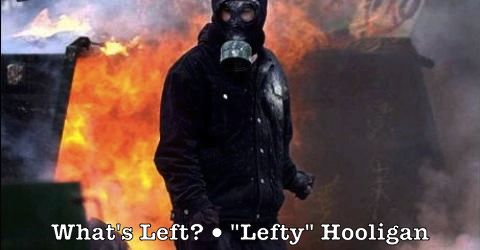
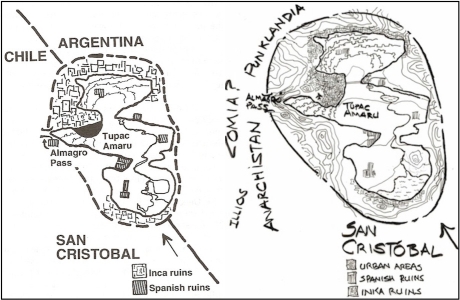
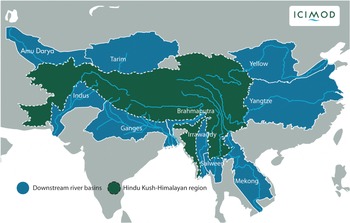




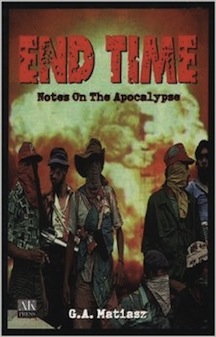
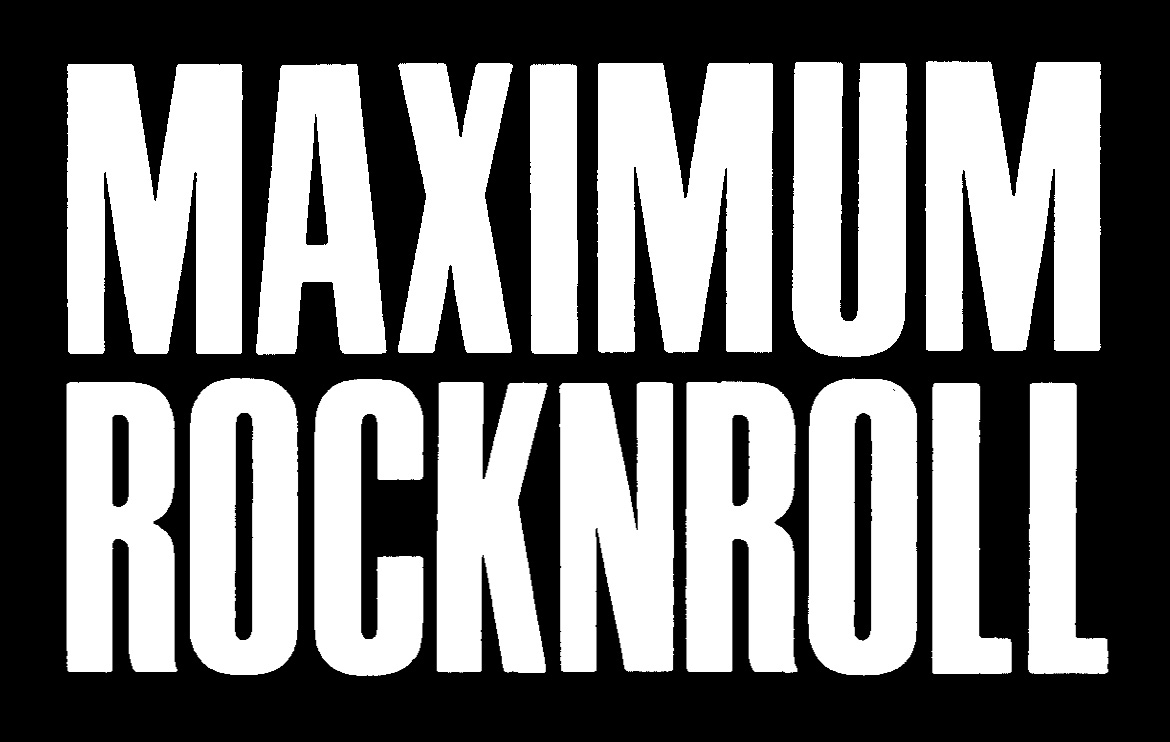
[…] version of this critique many years ago, from which I split off my July 17, 2017, piece called “San Cristobal and Zomia, an exercise in fantasy.” And like that essay, this commentary is not an official MRR column. It’s not Hooligan canon, […]